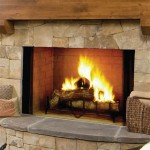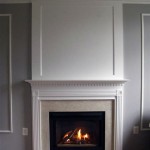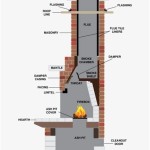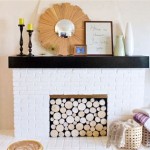Elevating Your Fireplace: Creative Wood Mantel Ideas
The fireplace stands as a focal point in many homes, offering warmth, ambiance, and a gathering place for family and friends. The mantel, positioned above the fireplace opening, serves as a crucial design element, providing a decorative surface and enhancing the overall aesthetic. Choosing the right wood mantel can significantly transform the look and feel of a room. This article explores a variety of fireplace wood mantel ideas, delving into different styles, materials, and design considerations to inspire homeowners seeking to upgrade their hearths.
The selection process for a wood mantel should involve careful consideration of several factors. The existing architectural style of the home, the dimensions of the fireplace, and the desired atmosphere all play a role in determining the ideal mantel. Exploring various options and understanding the characteristics of different wood types will contribute to a successful outcome, resulting in a fireplace that blends seamlessly with the surrounding décor and reflects personal taste.
Rustic Charm: Embracing Natural Imperfections
For homeowners seeking a warm and inviting atmosphere, a rustic wood mantel offers an appealing solution. These mantels often feature reclaimed wood, showcasing the natural imperfections of the material, such as knots, cracks, and variations in grain. This inherent character adds depth and authenticity to the fireplace, creating a sense of history and connection to the natural world.
Reclaimed wood offers an environmentally conscious option, repurposing timbers from old barns, factories, or other structures. The aged patina of reclaimed wood provides a unique aesthetic that cannot be replicated with new lumber. Alternatively, new wood can be distressed to emulate the appearance of aged wood, incorporating techniques such as sanding, staining, and texturing to achieve a similar effect.
Considerations for rustic mantels include the overall dimensions and weight of the wood. Larger, heavier mantels may require additional support to ensure secure installation. The finish of the wood is also important, as it will influence the overall appearance and durability of the mantel. Options range from natural oil finishes that enhance the wood's natural color to protective coatings that provide resistance to moisture and scratches.
Examples of rustic wood choices include: pine, oak, and cedar. Pine offers a softer wood that is easily distressed, while oak provides a harder, more durable option. Cedar offers a unique aroma and natural resistance to decay, making it well-suited for outdoor or damp environments.
Modern Minimalism: Clean Lines and Streamlined Designs
In contrast to the rustic aesthetic, modern mantels often embrace clean lines, minimalist designs, and a focus on simplicity. These mantels typically feature smooth, unadorned surfaces and a streamlined profile. The goal is to create a sophisticated and contemporary look that complements modern architectural styles.
Wood choices for modern mantels often include hardwoods such as maple, walnut, or cherry. These woods offer a fine grain and a consistent color, providing a smooth and elegant surface. Alternatively, engineered wood products such as medium-density fiberboard (MDF) can be used, offering a stable and consistent material that can be easily painted or veneered.
The finish of a modern mantel is typically a key consideration. Popular options include clear coats that showcase the natural beauty of the wood, as well as painted finishes that create a sleek and contemporary look. For painted mantels, it is important to choose a high-quality paint that is durable and resistant to chipping or scratching.
Installation of a modern mantel often involves a concealed mounting system, creating a clean and seamless appearance. This may require careful planning and execution to ensure that the mantel is securely attached to the wall. Consider using a sturdy wood beam or metal bracket to provide added stability.
The dimensions of a modern mantel are also important. A mantel that is too large or too small can disrupt the balance of the fireplace and the surrounding room. It is generally recommended to choose a mantel that is proportional to the size of the fireplace opening and the overall dimensions of the room.
Traditional Elegance: Classic Styles and Intricate Details
For homeowners who appreciate timeless design and classic elegance, a traditional wood mantel offers a sophisticated and refined option. These mantels often feature intricate details, such as moldings, carvings, and fluted columns. The goal is to create a focal point that exudes sophistication and timeless appeal.
Traditional mantels are often crafted from hardwoods such as mahogany, cherry, or walnut. These woods offer a rich color and a fine grain, providing a luxurious and elegant appearance. The wood may be stained and lacquered to enhance its natural beauty and provide a durable finish.
The design of a traditional mantel often incorporates classical architectural elements, such as pediments, corbels, and dentil moldings. These details add depth and dimension to the mantel, creating a sense of visual interest and sophistication. The mantel may also feature carved details, such as floral motifs, scrolls, or geometric patterns.
Installation of a traditional mantel often requires careful attention to detail. The mantel may be assembled from multiple pieces, and it is important to ensure that all pieces are properly aligned and securely attached. The mantel may also be painted or stained to match the surrounding trim and molding.
The scale of a traditional mantel can vary depending on the size of the fireplace and the overall proportions of the room. Larger mantels may be appropriate for grand fireplaces, while smaller mantels may be better suited for more intimate spaces. It is important to choose a mantel that is proportional to the size of the fireplace and the surrounding room.
Floating Mantels: A Modern and Minimalist Approach
Floating mantels offer a contemporary and minimalist take on the traditional fireplace mantel. These mantels appear to "float" on the wall, creating a clean and uncluttered look. They are often chosen for their visual appeal and ability to complement modern and contemporary interiors.
Floating mantels can be crafted from a variety of materials, including wood, concrete, and metal. Wood is a popular choice for its warmth and versatility. Options include solid wood, engineered wood, and reclaimed wood, each offering different aesthetics and performance characteristics.
The key to a successful floating mantel is the mounting system. These mantels typically rely on hidden brackets or internal supports to create the illusion of floating. The mounting system must be robust enough to support the weight of the mantel and any decorative items placed upon it. Professional installation is often recommended to ensure that the mantel is securely and safely installed.
When selecting a floating mantel, it is important to consider the dimensions of the fireplace and the surrounding wall space. The mantel should be proportional to the size of the fireplace opening and the overall dimensions of the room. The depth of the mantel is also an important consideration, as it will determine the amount of display space available.
The finish of a floating mantel can greatly influence its overall aesthetic. Options include natural wood finishes, painted finishes, and stained finishes. The finish should complement the surrounding décor and enhance the overall design of the room.
Considerations for Choosing Wood Type
Selecting the appropriate wood type for a mantel is a crucial decision, as it affects the appearance, durability, and overall character of the piece. Various wood species possess unique properties that make them suitable for different applications. Understanding these characteristics empowers homeowners to make informed choices aligned with their aesthetic preferences and functional requirements.
Hardwoods, such as oak, maple, and cherry, are known for their density, durability, and resistance to wear and tear. These woods are ideal for high-traffic areas or mantels that will be subjected to frequent use. Hardwoods typically exhibit a tighter grain pattern and a smoother surface than softwoods, lending them a more refined appearance. They are, however, generally more expensive than softwoods.
Softwoods, such as pine, cedar, and fir, are more readily available and generally more affordable than hardwoods. These woods are often easier to work with, making them a popular choice for DIY projects. Softwoods tend to have a more open grain pattern and a softer texture, which can add to their rustic charm. However, they may be more susceptible to scratches and dents than hardwoods.
The color and grain pattern of the wood are also important considerations. Different wood species exhibit a wide range of colors, from the light tan of maple to the deep red of cherry. The grain pattern can also vary significantly, from the straight grain of pine to the intricate swirls of burl wood. Selecting a wood species with a color and grain pattern that complements the surrounding décor is essential for creating a cohesive and visually appealing design.
Furthermore, the moisture content of the wood is a critical factor to consider. Wood that is not properly seasoned can warp, crack, or shrink over time, especially when exposed to heat from the fireplace. It is important to choose wood that has been kiln-dried to a stable moisture content to minimize the risk of these problems. Discussing the seasoning process with the wood supplier is a wise precaution.
Finishing Touches: Enhancing the Wood's Natural Beauty
The finishing process plays a pivotal role in enhancing the beauty and protecting the integrity of a wood mantel. Whether aiming for a natural look or a more polished appearance, proper finishing techniques can significantly elevate the overall aesthetic. A variety of finishing options exist, each offering unique benefits and imparting different characteristics to the wood.
Clear finishes, such as varnish, lacquer, and polyurethane, are designed to protect the wood while allowing its natural color and grain pattern to shine through. These finishes typically provide a durable and water-resistant barrier, protecting the wood from scratches, stains, and moisture damage. The choice of clear finish depends on the desired level of gloss and the degree of protection required.
Stains are used to alter the color of the wood, adding depth and richness to its appearance. Stains are available in a wide range of colors, from light and natural tones to dark and dramatic hues. When applying stain, it is important to follow the manufacturer's instructions carefully to ensure even coverage and prevent blotching. Applying a sealer before staining can help to create a more uniform finish.
Paint offers a versatile option for customizing the appearance of a wood mantel. Paint can be used to create a bold and contemporary look, or it can be used to match the trim and molding in the surrounding room. When painting a wood mantel, it is important to use a high-quality primer to ensure proper adhesion and prevent the paint from chipping or peeling. Several coats of paint may be required to achieve full coverage.
Oil finishes, such as linseed oil and tung oil, penetrate the wood, nourishing it from within and enhancing its natural beauty. Oil finishes provide a soft, matte finish that emphasizes the wood's grain pattern and texture. These finishes are relatively easy to apply and maintain, but they may not provide the same level of protection as clear finishes or paint.
:max_bytes(150000):strip_icc()/sandandsisal-bdc76ad938a44d28ae9e23ef6c9fa331.jpg?strip=all)
17 Diy Fireplace Mantel Plans

40 Fabulous Fireplace Design Ideas For Any Budget Or Style

7 Design Ideas Using Dark Wood Fireplace Mantels Elmwood Reclaimed Timber

10 Rustic Fireplace Mantel Ideas Blog Red Door

30 Timeless Wood Mantels For Brick Fireplace Designs

Cozy Fireplace With Stylish Design

Diy Rustic Fireplace Mantel The Cure For A Boring

50 Cozy Fireplace Ideas Best Mantel Decor

Wood Fireplace Mantel Installation Design Heartland Iowa City

How To Style A Mantel For Autumn Home Fireplace Living Room








